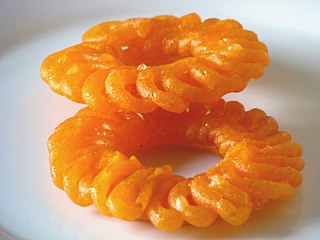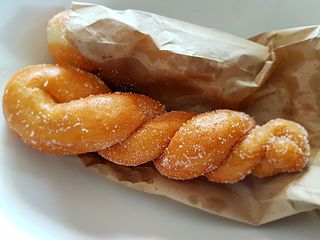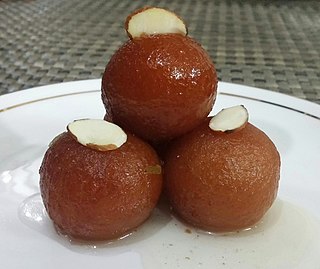
A doughnut or donut is a type of fried dough confection or dessert food. The doughnut is popular in many countries and prepared in various forms as a sweet snack that can be homemade or purchased in bakeries, supermarkets, food stalls, and franchised specialty vendors.

A zeppola is an Italian pastry consisting of a deep-fried dough ball of varying size but typically about 4 inches (10 cm) in diameter. This doughnut or fritter is usually topped with powdered sugar, and may be filled with custard, jelly, cannoli-style pastry cream, or a butter-and-honey mixture. The consistency ranges from light and puffy, to bread- or pasta-like. It is eaten to celebrate Saint Joseph's Day, which is a Catholic feast day.

A churro is a fried-dough pastry—predominantly choux—based snack. Churros are traditional in Spain and Portugal, from where they originate, as well as the Philippines and Ibero-America. They are also consumed in the Southwestern United States, France and other areas that have received immigration from Spanish and Portuguese-speaking countries. In Spain, churros can either be thin or long and thick, where they are known as porras in some regions. They are normally eaten for breakfast dipped in champurrado, hot chocolate, dulce de leche or café con leche. Sugar is often sprinkled on top.

Funnel cake is a regional food popular in North America at carnivals, fairs, sporting events, and seaside resorts.

A buñuelo is a fried dough ball. It is a popular snack in Argentina, Belize, Bolivia, Colombia, Cuba, Ecuador, El Salvador, Greece, Guam, Guatemala, Italy, Israel, Mexico, Africa, Nicaragua, Panama, the Philippines, Puerto Rico, Spain, Turkey, Uruguay, and Venezuela. It is traditionally prepared at Christmas, Ramadan, and among Sephardic Jews at Hanukkah. It will usually have a filling or a topping. In Mexican cuisine, it is often served with a syrup made with piloncillo.
Bosnia and Herzegovina cuisine is balanced between Western and Eastern influences. The food is closely related to former Yugoslav, Middle Eastern, Mediterranean and other Balkan cuisines.

Lokma (Turkish), Loqma, Loukoumades, or Bāmiyeh are pastries made of leavened and deep fried dough, soaked in syrup or honey, sometimes coated with cinnamon or other ingredients. The dish was described as early as the 13th century by al-Baghdadi as luqmat al-qādi, "judge's morsels".

Imarti is an Indian sweet. It is made by deep-frying vigna mungo flour batter in a kind of circular flower shape, then soaked in sugar syrup. Alternative names include Amriti, Emarti, Omriti, Jahangir and Jhangiri/Jaangiri. This dish is not to be confused with Jalebi which has comparatively thinner material and is sweeter than Imarti.

Makroudh is an Algerian and Tunisian sweet pastry filled with dates and nuts or almond paste, that has a diamond shape – the name derives from this characteristic shape.

Kanafeh is a traditional Arab dessert made with thin noodle-like pastry, or alternatively fine semolina dough, soaked in sweet, sugar-based syrup, and typically layered with cheese, or with other ingredients such as clotted cream or nuts, depending on the region. It is popular in the Arab world, particularly the Levant and Egypt, and especially in Palestine. In addition, variants are found in Turkey, Greece, and the Balkans, as well as in the Caucasus.

Baklava is a rich, sweet dessert pastry made of layers of filo filled with chopped nuts and sweetened and held together with syrup or honey. It is characteristic of the cuisines of the Levant, the Caucasus, Balkans, Maghreb, and of Central and West Asia.

A Doughwich is a combination of a doughnut and a sandwich. The doughwich is typically constructed using a glazed, deep-fried flour doughnut and split in the middle like a bagel. Various types of foods, such as cheese, bacon, peanut butter and more, are usually added between the slices creating a sandwich.

Awameh which is Arabic for “Floater”, is a kind of fried-dough Levantine pastry similar to doughnut holes, made of deep fried dough, soaked in sugar syrup or honey and cinnamon, and sometimes sprinkled with sesame. In the Middle East, they are also known as ‘zlabieh’ (زلابية).normally Jalebi has a flower shape, and different flavors than Awameh. They are associated with Christmas and the "circumcision of Christ", or baptism, called Ghtas. It is also referred to as Awwameh.

Bambaloni, also referred to as bambalouni, is a sweet Tunisian donut. It can be made at home or bought from fast food shops. It is prepared with a flour dough fried in oil. The bambaloni is eaten sprinkled with sugar or soaked in honey. It can be eaten at any time of day. It is the Tunisian version of the Sfenj donut that is widely consumed throughout the Maghreb, which is also known as sfinz in Libya.

Twisted doughnuts are yeast donuts or sticks of pastry made from braided wheat or glutinous rice flour, deep-fried in oil. In Korea, they are known as kkwabaegi (꽈배기), and in the Philippines, as shakoy.



























